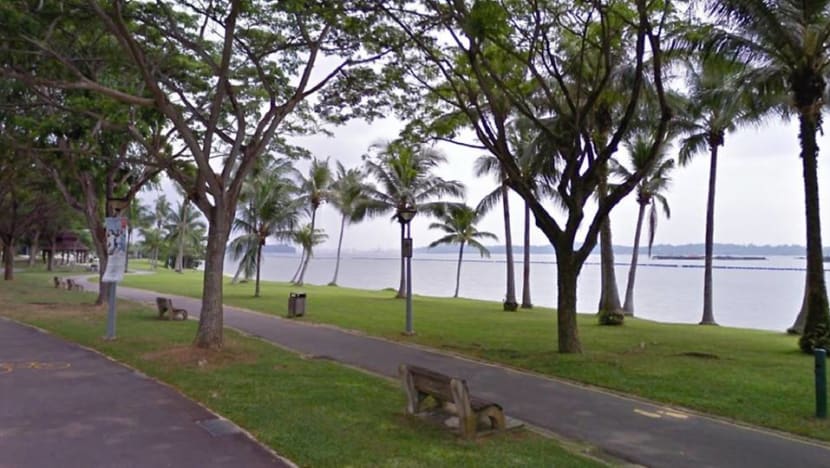FAQ: What is the bacteria that caused NEA to advise against swimming at two Singapore beaches?
The National Environment Agency on Monday (Feb 5) advised people against swimming at Pasir Ris Beach and Sembawang Park Beach after more frequent readings of elevated enterococcus bacteria. What is this bacteria and why is it harmful?

A sign at Sembawang Park Beach showing the weekly tests for Enterococcus bacteria. (Photo: CNA/Natasha Ganesan)

This audio is generated by an AI tool.
SINGAPORE: More frequent readings of elevated Enterococcus bacteria levels at two Singapore beaches have prompted authorities to advise people against swimming there.
The National Environment Agency (NEA) on Monday (Feb 5) also advised people against engaging in other "primary contact water activities" – such as wakeboarding, windsurfing and water immersion training – at the two beaches.
Other water activities, such as sailing, kayaking and canoeing, can continue, said the agency.
What is Enterococcus bacteria and what are the symptoms when someone is infected?
What is Enterococcus bacteria?
According to NEA, Enterococcus is a genus of bacteria that is commonly found in the gastrointestinal tracts of warm-blooded animals, including humans.
There are at least 18 species of the bacteria, according to health website Healthline, with Enterococcus faecalis – also known as E faecalis – one of the most common species.
E faecalis normally lives harmlessly in the intestines, but it can cause more serious infection if it spreads to other parts of the body.
Where does this bacteria come from?
NEA said that based on its preliminary investigations, the elevated bacteria levels at the two beaches are from inland sources that are not transboundary in nature.
In response to CNA's queries about the source, NEA said it is working with other agencies such as PUB, the National Parks Board and the Singapore Food Agency to investigate and mitigate the possible sources.
According to the United States Environmental Protection Agency (EPA), the sources of bacteria such as Enterococcus include discharged sewage, dumping from boats, and wildlife waste.
There are also natural, non-faecal sources of bacteria, including plants, sand, soil and sediments.
According to the US National Oceanic Atmospheric Administration, sources such as decaying seaweed, for example, can cause heightened levels of Enterococcus in the water but may pose little to no risk to humans.
High levels of bacteria from human or animal waste may cause more dangerous contamination.
The Ministry of Sustainability and the Environment (MSE) said on its website that beach water is "vulnerable to contamination".
Some sources of pollution include minor leakage from older sewers, sea animals and discharge from moored vessels.

What are the symptoms of infection?
The more frequent readings of elevated enterococcus bacteria at the two beaches increase the risk of gastrointestinal infection when the water is swallowed, said NEA.
NEA warned that "primary contact activities" – defined as when a person's whole body, or face and trunk, are frequently immersed and when some water will likely be swallowed – should be avoided.
These activities include swimming, wakeboarding and windsurfing.
According to Healthline, some symptoms of infection include fever, chills, fatigue, abdominal pain, vomiting and diarrhoea.
The infection is typically treated with antibiotics.
Should you be worried about swimming at the beach?
NEA conducts weekly tests of the water at seven popular recreational beaches in Singapore: Changi, East Coast Park, Pasir Ris, Punggol, Seletar Island, Sembawang Park and Sentosa Island.
The Beach Short-term Water Quality Information is published on NEA's website and updated regularly.
The three levels are normal, elevated and high.
It is safe to enter the water and all activities can continue when the water quality is normal.
But when bacteria levels are elevated, people are advised against primary contact activities. Children, the elderly and those with compromised immunity should reduce such activities.
When there are high levels of bacteria, all beachgoers should minimise primary contact activities.
NEA has said that people do not need to be "unduly concerned" if certain stretches of a beach go into elevated or high levels for a particular week, as enterococcus levels are transient and beach water is continuously flushed and mixed by currents.

Based on the weekly samples, the agency grades each of the seven beaches based on the World Health Organization's (WHO) recreational water quality guidelines.
It takes into account the incidences of elevated bacteria count in the beach water samples over the past three years.
The grades for Pasir Ris Beach and Sembawang Park Beach fell from good to fair in this year’s beach grading exercise because their waters entered the elevated range more frequently.
Beaches with Enterococcus bacteria levels greater than 200cfu/100ml for more than 5 per cent of the samples over a three-year period are graded fair. Those with higher levels are graded poor or very poor.
The other five beaches – East Coast, Changi, Punggol, Seletar Island and Sentosa – maintained a good grade.
Before the latest advisory, the last time a beach advisory was issued was from August 2008 to January 2012 for Pasir Ris Beach, when its rating was fair.
Primary contact activities at the beach resumed in February 2012 after its rating rose to Good.















